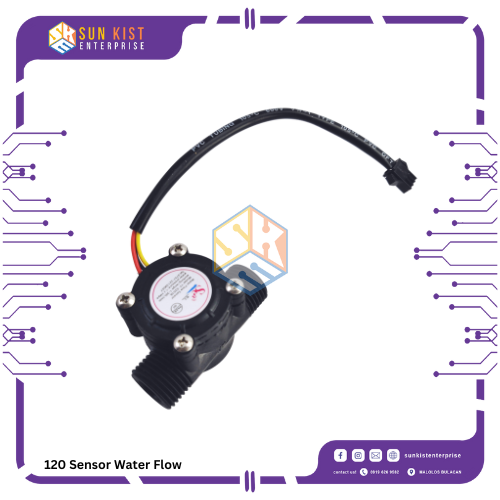Description
A **Water Flow Sensor** is a device used to measure the rate of water flow in a pipe or a system. It is commonly used in various applications, including industrial processes, water supply monitoring, irrigation systems, and more. Here are the key features and functions of a water flow sensor:
1. **Flow Measurement:** The primary function of a water flow sensor is to measure the flow rate of water, typically in liters per minute (LPM) or gallons per minute (GPM). This measurement is crucial for monitoring and controlling water-related processes.
2. **Sensing Mechanism:** Water flow sensors employ different sensing mechanisms, but one of the most common methods is the use of a turbine or paddle wheel. When water flows through the sensor, it causes the turbine or paddle to spin. The rate of rotation is directly proportional to the flow rate.
3. **Output Signals:** Water flow sensors can provide various types of output signals to indicate the flow rate. Common types include analog voltage or current signals, digital pulses, or frequency output. These signals can be interfaced with microcontrollers or monitoring systems for data collection.
4. **Accuracy:** The accuracy of a water flow sensor is a critical factor, especially in applications where precise flow rate measurements are essential. High-quality sensors provide accurate and reliable data.
5. **Wide Range of Applications:** Water flow sensors are used in a wide range of applications, including industrial processes (e.g., cooling systems), HVAC (Heating, Ventilation, and Air Conditioning) systems, irrigation, water supply networks, and environmental monitoring.
6. **Inline and Insertion Sensors:** Water flow sensors come in different forms, including inline and insertion types. Inline sensors are installed directly in the water pipe, while insertion sensors are inserted into a pipe, typically for larger-diameter pipes.
7. **Material Compatibility:** Water flow sensors are constructed from materials compatible with water, often including stainless steel, brass, or plastics. The choice of material depends on the specific application and the type of water being measured.
8. **Maintenance:** Water flow sensors typically require minimal maintenance, but regular calibration and cleaning may be necessary to ensure accurate measurements over time.
9. **Display and Data Logging:** Some water flow sensors come with built-in displays for immediate visual feedback, and others are designed for data logging, allowing you to record flow data over time.
10. **Alarm and Control:** In some applications, water flow sensors can be integrated with control systems to trigger alarms or control the flow of water based on preset thresholds.
11. **Environmental Monitoring:** Water flow sensors are used in environmental monitoring applications to measure the flow of rivers, streams, and wastewater.
In summary, a **Water Flow Sensor** is a valuable tool for measuring the rate of water flow in various applications. It provides real-time data on water consumption, enabling efficient water management, process control, and environmental monitoring. The choice of a water flow sensor depends on the specific requirements of the application and the desired level of accuracy and functionality.












Reviews
There are no reviews yet.